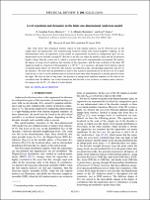Please use this identifier to cite or link to this item:
https://hdl.handle.net/20.500.12202/6445Full metadata record
| DC Field | Value | Language |
|---|---|---|
| dc.contributor.author | Santos, Lea F. | - |
| dc.contributor.author | Torres-Herrera, E. Jonathan | - |
| dc.contributor.author | Méndez-Bermúdez, J. A. | - |
| dc.date.accessioned | 2020-11-19T17:22:17Z | - |
| dc.date.available | 2020-11-19T17:22:17Z | - |
| dc.date.issued | 2019-08-29 | - |
| dc.identifier.citation | Santos, Lea F., E Jonathan Torres-Herrera, JA Méndez-Bermúdez. (2019). Level repulsion and dynamics in the finite one-dimensional Anderson model. Physical Review E 100(2): 022142 | en_US |
| dc.identifier.issn | Print: 1539-3755 Electronic: 1550-2376 | - |
| dc.identifier.uri | https://doi.org/10.1103/PhysRevE.100.022142 | en_US |
| dc.identifier.uri | https://hdl.handle.net/20.500.12202/6445 | - |
| dc.description | Research article, peer-reviewed. Open Access. | en_US |
| dc.description.abstract | Abstract This work shows that dynamical features typical of full random matrices can be observed also in the simple finite one-dimensional (1D) noninteracting Anderson model with nearest-neighbor couplings. In the thermodynamic limit, all eigenstates of this model are exponentially localized in configuration space for any infinitesimal on-site disorder strength W. But this is not the case when the model is finite and the localization length is larger than the system size L, which is a picture that can be experimentally investigated. We analyze the degree of energy-level repulsion, the structure of the eigenstates, and the time evolution of the finite 1D Anderson model as a function of the parameter ξ∝(W2L)−1. As ξ increases, all energy-level statistics typical of random matrix theory are observed. The statistics are reflected in the corresponding eigenstates and also in the dynamics. We show that the probability in time to find a particle initially placed on the first site of an open chain decays as fast as in full random matrices and much faster than when the particle is initially placed far from the edges. We also see that at long times, the presence of energy-level repulsion manifests in the form of the correlation hole. In addition, our results demonstrate that the hole is not exclusive to random matrix statistics, but emerges also for W=0, when it is in fact deeper. | en_US |
| dc.description.sponsorship | ACKNOWLEDGMENTS E.J.T.-H. and J.A.M.-B. acknowledge funding from VIEPBUAP (Grants No. MEBJ-EXC19-G, No. LUAG-EXC19-G, and No. CELU-EXC19-I), Mexico. They are also grateful to LNS-BUAP for allowing the use of the supercomputing facility. L.F.S. was supported by the NSF Grant No. DMR- 1603418. | en_US |
| dc.language.iso | en_US | en_US |
| dc.publisher | American Physical Society | en_US |
| dc.relation.ispartofseries | Physical Review E;100(2) | - |
| dc.rights | Attribution-NonCommercial-NoDerivs 3.0 United States | * |
| dc.rights.uri | http://creativecommons.org/licenses/by-nc-nd/3.0/us/ | * |
| dc.subject | Single-particle dynamics | en_US |
| dc.subject | Anderson localization | en_US |
| dc.subject | Random & disordered media | en_US |
| dc.subject | Condensed Matter & Materials Physics | en_US |
| dc.subject | Statistical Physics | en_US |
| dc.title | Level repulsion and dynamics in the finite one-dimensional Anderson model. | en_US |
| dc.type | Article | en_US |
| dc.contributor.orcid | 0000-0001-9400-2709 | |
| local.yu.facultypage | https://www.yu.edu/faculty/pages/santos-lea | |
| Appears in Collections: | Stern College for Women -- Faculty Publications | |
Files in This Item:
| File | Description | Size | Format | |
|---|---|---|---|---|
| Santos Level 2019 PhysRevE.100.022142.pdf | 1.04 MB | Adobe PDF |  View/Open |
This item is licensed under a Creative Commons License

